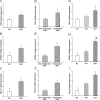Evidence of association of circulating epigenetic-sensitive biomarkers with suspected coronary heart disease evaluated by Cardiac Computed Tomography
- PMID: 30673762
- PMCID: PMC6343931
- DOI: 10.1371/journal.pone.0210909
Evidence of association of circulating epigenetic-sensitive biomarkers with suspected coronary heart disease evaluated by Cardiac Computed Tomography
Abstract
Circulating biomarkers available in clinical practice do not allow to stratify patients with coronary heart disease (CHD) prior the onset of a clinically relevant event. We evaluated the methylation status of specific genomic segments and gene expression in peripheral blood of patients undergoing Cardiac Computed Tomography (CCT) for CHD (n = 95). We choose to investigate cholesterol metabolism. Methylation and gene expression of low density lipoprotein receptor (LDLR), sterol regulatory element-binding factor 2 (SREBF2) and ATP-binding cassette transporter 1 (ABCA1) were evaluated by qRT-PCR. Calcium score (CACS), stenosis degree, total plaque volume (TPV), calcified plaque volume (CPV), non-calcified plaque volume (NCPV) and plaque burden (PB) were assessed in all CHD patients (n = 65). The percentage of methylation at the specific analyzed segment of LDLR promoter was higher in CHD patients vs healthy subjects (HS) (n = 30) (p = 0.001). LDLR, SREBF2 and ABCA1 mRNAs were up-regulated in CHD patients vs HS (p = 0.02; p = 0.019; p = 0.008). SREBF2 was overexpressed in patients with coronary stenosis ≥50% vs subjects with stenosis <50% (p = 0.036). After adjustment for risk factors and clinical features, ABCA1 (p = 0.005) and SREBF2 (p = 0.010) gene expression were identified as independent predictors of CHD and severity. ROC curve analysis revealed a good performance of ABCA1 on predicting CHD (AUC = 0.768; p<0.001) and of SREBF2 for the prediction of disease severity (AUC = 0.815; p<0.001). Moreover, adjusted multivariate analysis demonstrated SREBF2 as independent predictor of CPV, NCPV and TPV (p = 0.022; p = 0.002 and p = 0.006) and ABCA1 as independent predictor of NCPV and TPV (p = 0.002 and p = 0.013). CHD presence and characteristics are related to selected circulating transcriptional and epigenetic-sensitive biomarkers linked to cholesterol pathway. More extensive analysis of CHD phenotypes and circulating biomarkers might improve and personalize cardiovascular risk stratification in the clinical settings.
Conflict of interest statement
The authors have declared that no competing interests exist.
Figures





References
Publication types
MeSH terms
Substances
LinkOut - more resources
Full Text Sources
Other Literature Sources

